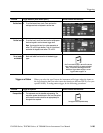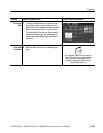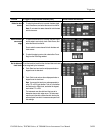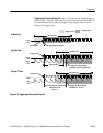
Triggering
3- 108
CSA7000 Series, TDS7000 Series, & TDS6000 Series Instruments User Manual
Overview Control elements and resourcesTrigger on a pattern (Cont.)
To define a time
qualified pattern
trigger
You can time qualify a pattern logic trigger. That is, you
specify a t ime that the boolean logic function (AND, NAND,
OR, or NOR) m ust be TRUE. To specify the time limit as well
as the type of time qualifi cation (More Than or Less Than the
time limit specified) for a pattern trigger, do the followi ng
step:
9. Select Trigger When Time, and set the time using the
multipurpose knob or keypad.
When you select TRUE for Less Than and specify a
time, the input conditions that you speci fy must drive the
logic function high (TRUE) for less than the time you
specify. Conversely, the TRUE for More Than item
requires the boolean function to be TRUE for longer
than the time that you specify.
Note the position of the trigger indicator. Triggering
occurs at the point that the instrument determines t hat
the logic function that you specify is TRUE within the
time that you specify. The instrument determines the
trigger point in the following manner:
H It waits for the logic condit ion to become TRUE.
H It starts timing and waits for the logic function to
become FALSE.
H It compares the times and, if the time TRUE is
longer (for TRUE for more than) or shorter (for
TRUE for less than), then it triggers a waveform
display at the point the logi c condition became
FALSE. This time can be, and usually is, different
from the time set.
In the figure, the delay between the vertical bar cursors
is the time the logic function is TRUE. Since this time is
more (4.9 ns) than that set in the TRUE for More Than
item (3 ns), the instrument issues the trigger at that
point, not at the point at which it has been TRUE for
3ns.
Logic function (AND)
becomes TRUE
Logic function becomes
FALSE and triggers
acquisition
Time logic
function is TRUE
Time Logic Function Must be TRUE = 3 ns


















